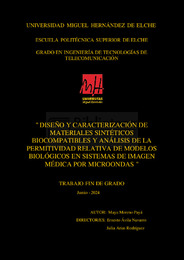Por favor, use este identificador para citar o enlazar este ítem:
https://hdl.handle.net/11000/32698Registro completo de metadatos
| Campo DC | Valor | Lengua/Idioma |
|---|---|---|
| dc.contributor.advisor | Ávila Navarro, Ernesto | - |
| dc.contributor.advisor | Arias, Julia | - |
| dc.contributor.author | Moreno Payá, Maya | - |
| dc.contributor.other | Departamentos de la UMH::Ingeniería | es_ES |
| dc.date.accessioned | 2024-07-24T12:04:26Z | - |
| dc.date.available | 2024-07-24T12:04:26Z | - |
| dc.date.created | 2024-06 | - |
| dc.identifier.uri | https://hdl.handle.net/11000/32698 | - |
| dc.description.abstract | Durante todo el trabajo se abarcarán estudios basados en los nuevos sistemas de detección de cáncer de mama mediante las microondas. Las grandes ventajas y facilidades que presentan estos sistemas como la rapidez y bajos costes, además de no ser invasivos ni ionizantes, han dado lugar al uso de estos en muchos ámbitos, como es nuestro caso, en el ámbito de la medicina. La permitividad compleja es una propiedad física muy importante, que permite obtener información de los materiales cuando interactúan con un campo eléctrico, y que estará presente en todo el trabajo. Esta propiedad se analiza en varios estudios para determinar la degradación de materiales sintéticos biocompatibles, que previamente serán diseñados mediante mezclas y disoluciones, además de poder distinguir el tipo de material o tejido biológico presente, debido al cambio de esta propiedad física, lo que utilizaremos como base de nuestro trabajo para poder diferenciar tejido y tumor. Otro objetivo de este trabajo es poder determinar la permitividad relativa mediante los resultados obtenidos en simulaciones diseñadas simulando de manera simple el sistema de detección de cáncer de mama que está construido en el laboratorio de investigación del departamento de ciencia de los materiales, óptica y electrónica. Finalmente, este trabajo pretende afirmar que este tipo de sistemas basados en las microondas son efectivos y presentan un gran potencial con resultados acertados y precisos frente a los sistemas de la actualidad. | es_ES |
| dc.description.abstract | During the work, we take on different studies that are based on the new breast cancer detection systems using microwaves. These systems present lots of advantages and eases, like the speedy and low costs. Apart from that, they are not invasive and have no ionizing characteristics, which has given rise to the use of these systems in lots of fields, although in our case we are applying it in field of medicine. Complex permittivity is a very important physics property, it allows get information about materials with an electric camp interaction and it will be present during all work. With it, different studies will can be determined to demonstrate the degradation of biocompatible synthetic materials, which will previously be designed through mixtures and solutions, furthermore the type of the material or the biologic tissue can be differentiate because of the permittivity variation, this quality can determine the difference between tissue and malignant tissue and it will be the basis of the entire work. The other objective is the possibility of determining the relative permittivity through the obtained results in simulations in the simple system for breast cancer detection which is designed in the research laboratory of the department of materials science, optics and electronics. Finally, this work pretends to affirm the effectiveness of microwave systems and the high, accurate, and precise results compared to modern systems. | es_ES |
| dc.format | application/pdf | es_ES |
| dc.format.extent | 95 | es_ES |
| dc.language.iso | spa | es_ES |
| dc.publisher | Universidad Miguel Hernández de Elche | es_ES |
| dc.rights | info:eu-repo/semantics/openAccess | es_ES |
| dc.rights.uri | http://creativecommons.org/licenses/by-nc-nd/4.0/ | * |
| dc.subject | microondas | es_ES |
| dc.subject | permitividad relativa | es_ES |
| dc.subject | electromagnetismo | es_ES |
| dc.subject | propiedades dieléctricas | es_ES |
| dc.subject | antenas | es_ES |
| dc.subject | microwave | es_ES |
| dc.subject | relative permittivity | es_ES |
| dc.subject | electromagnetism | es_ES |
| dc.subject | dielectric properties | es_ES |
| dc.subject | antennas | es_ES |
| dc.subject.classification | Ingeniería de Tecnologías de Telecomunicación | es_ES |
| dc.subject.other | CDU::6 - Ciencias aplicadas::62 - Ingeniería. Tecnología | es_ES |
| dc.title | Diseño y caracterización de materiales sintéticos biocompatibles y análisis de la permitividad relativa de modelos biológicos en sistemas de imagen médica por microondas | es_ES |
| dc.type | info:eu-repo/semantics/bachelorThesis | es_ES |

Ver/Abrir:
TFG-Moreno Payá, Maya.pdf
4,96 MB
Adobe PDF
Compartir:
 La licencia se describe como: Atribución-NonComercial-NoDerivada 4.0 Internacional.
La licencia se describe como: Atribución-NonComercial-NoDerivada 4.0 Internacional.
.png)